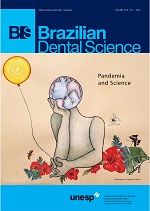Prevalence of soft tissue calcifications in cone beam computed tomography images in the region of head and neck
DOI:
https://doi.org/10.14295/bds.2020.v23i2.1864Abstract
Objective: to evaluate the prevalence of calcifications in the soft tissues of the cervical-facial region using cone beam computed tomography (CBCT) images. Material and Methods: two hundred and ten CBCT exames was analyzed by 01 examiner previously trained, with fild of view (FOV) of 16 x 13 cm and voxel of 0.25 mm, in ICAT Vision software (Imaging Science International, Hatfield, PA, USA) in coronal, axial and sagittal sections. The following calcifications were evaluated: tonsiloliths, sialolites, calcification of the styloid complex, calcified carotid atheromas, calcifications in laryngeal cartilages, calcified lymph nodes and osteoma cutis. The findings were tabulated according to the total of the sample, related to the gender, age group of the individuals. Results: Calcification of the styloid complex was the most frequent in the sample studied in both genres (39.04%), followed by the presence of tonsiloliths (19.52%), and calcified lymph nodes (6,67%). Conclusion: calcifications are frequent radiographic findings in CBCT and important for the diagnosis of some possible pathologies that do not present clinical symptoms.
KEYWORDS
Cone-beam computed tomography; Prevalence; Soft tissue calcification.
Downloads
Downloads
Additional Files
Published
How to Cite
Issue
Section
License
Brazilian Dental Science uses the Creative Commons (CC-BY 4.0) license, thus preserving the integrity of articles in an open access environment. The journal allows the author to retain publishing rights without restrictions.
=================




























